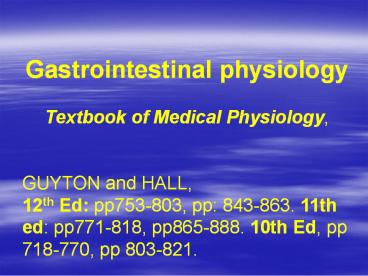Gastrointestinal physiology - PowerPoint PPT Presentation
Title:
Gastrointestinal physiology
Description:
Gastrointestinal physiology Textbook of Medical Physiology, GUYTON and HALL, 12th Ed: pp753-803, pp: 843-863. 11th ed: pp771-818, pp865-888. 10th Ed, pp 718-770, pp ... – PowerPoint PPT presentation
Number of Views:1171
Avg rating:3.0/5.0
Title: Gastrointestinal physiology
1
Gastrointestinal physiology Textbook of Medical
Physiology, GUYTON and HALL, 12th Ed
pp753-803, pp 843-863. 11th ed pp771-818,
pp865-888. 10th Ed, pp 718-770, pp 803-821.
2
(No Transcript)
3
- Physiological processes are taking place along
the gastrointestinal (GI) tract. - 1. Motility.
- 2. Secretion
- 3. Digestion.
- 4. Absorption.
4
Functional structures in the gastrointestinal
tract
- Smooth muscle cells
- Interstitial cells of Cajal
- Secretory cells
5
(No Transcript)
6
Other related structures
- Control systems of GI functions.
- - Neural control
- - Enteric nervous system
- - Autonomic nervous system
- - Hormonal control GI endocrine
- Blood flow to the GI.
7
(No Transcript)
8
(No Transcript)
9
Functional structures in the gastrointestinal
tract
- Smooth muscle cells (SMCs)
10
(No Transcript)
11
(No Transcript)
12
Smooth Muscle cells Characteristics
- Electrical activity
- - Slow waves (basic electrical rhythm)
13
Membrane potential (mV)
Acetylcholine
14
Contraction of GI smooth muscle
Calcium activates contraction Depends on influx
of calcium from extracellular space through
calcium channels Calcium- calmodulin complex
activates myosin light chain kinase
15
Smooth Muscle cells Characteristics
- Gap junctions
- ? Communication between cells
- ? Functional syncytium
16
Chemical control of SMCs
17
Control of smooth muscle cells activity
- Electrical control
- - Rhythm or phasic contractions
- Chemical control
- - tonic contractions
18
Interstitial Cells of Cajal (ICCs)
19
Characteristics of ICCs
- Communications
- - ICCs-ICCs gap junctions
- - ICCs-smooth muscle cells gab junctions
- - inputs from ENS
- Generation of action potentials
- ? pacemaker cells of the GI tract
20
Secretory Cells
- Mucous secretion and serous secretion
- Solitary cells
- Pits
- Compound glands
- Secretory organs
21
(No Transcript)
22
(No Transcript)
23
Characteristics of ENS
- Enteric Neurons
- Excitatory
- Inhibitory
- Neurotransmitters
- Ach, SP (Substance P), VIP (Vasoactive
intestinal peptide), CGRP (Calcitonin gene
related peptide), GRP (Gastrin releasing
peptide)etc
24
Autonomic Nervous System (ANS)
- Sympathetic
- Parasympathetic
25
(No Transcript)
26
Parasympathetic N.S
Sympathetic N.S.
CNS
27
Enteric Endocrine System
- Gastrin
- Chlecystokinin (CCK)
- Secretin
- GIP (Gastric Inhibitory peptide) or (Glucose
dependent Insulinotropic Polypeptide)
28
Enteric Endocrine System
- Glucagon-like peptide-1(GLP-1), Motilin, Ghrelin,
Amylin, Enterostatin, Neuropeptide Y (NPY),
polypeptide YY, Pancreatic polypeptide which is
closely related to polypeptide YY and NPY - Somatostatin,, Neurotensin, Thyrotropin
releasing hormone (TRH), Adrenocorticotropic
hormone ACTH.
29
Functions of Hormones
- Control of motility
- Control of secretion
- Control of blood flow
- Regulation of food intake
- Regulation of metabolic activities in the body
30
Blood Flow of the GI
- Related to GI activities
- -Controlled by
- - Hormones (Secretin, CCK)
- - ENS (VIP, SP, CGRP)
- - Vasodilators
- Kinins (Kallidin, Bradykinin)
- - Decreased O2 concentration
- - ANS
- (Sympathetic and parasympathetic)
31
(No Transcript)































